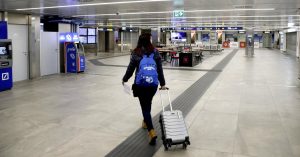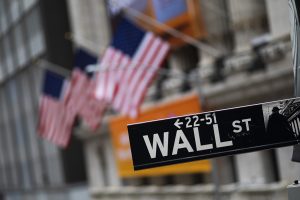It’s been nearly a month since governors first called on the
federal government to help provide testing so states could monitor
the spread of the novel coronavirus.
They’re still waiting. And without knowing who’s ill and
where, they can’t realistically slow the pandemic.
While President Donald Trump is touting a dramatic uptick in
testing across the country, governors and public health officials
say they are still being forced to dramatically ration the tests,
while labs are confronting daunting backlogs that delay the
results.
“I watch a news conference and they tell us we have testing
capacity, but I am telling you we don’t have testing capacity. It
is not out there yet,” said Minnesota Gov. Tim Walz during a
Wednesday news conference. His state has a current backlog of 1,700
samples waiting to be processed.
Walz blames the Trump administration’s decision to prioritize
14 of the nation’s hardest-hit areas, supplying them with needed
material and leaving the rest of the nation to scramble.
“The minute they made that decision … our supply chain of
reagents for our testing were dried up,” he said.
Even as President Donald Trump calls on states to do more and
says
the federal government is not “a shipping clerk,” governors
have been on the phone with Vice President Mike Pence and other
federal officials, begging for additional supplies, testing kits,
swabs, reagents and protective equipment.
“I think it’s critical the feds move a lot faster on this
stuff,” Massachusetts Gov. Charlie Baker said on Wednesday.
Oklahoma Gov. Kevin Stitt said his state is “critically low”
on test kits and that he has been pushing the federal government
for help.
The shortage of tests means that in many states people who
believe they might have contracted the virus can’t know for sure
and are told to stay home for weeks. It means health care workers
don’t know whether they’ve contracted the illness even as they
treat infected patients and tend to members of high-risk groups,
such as the elderly, who might be in the hospital for other
reasons. And it means public health officials are left guessing
where they should direct resources because they can’t be certain
whether there are clusters of cases.
Trump on Thursday insisted that governors have all they need,
telling reporters he was hearing “very good things on the
ground.”
“I can tell you what we’re doing is working with local
governors to get them what they want,” Trump said.
But the president’s words don’t match reality, state and
local officials say.
“We’re the boots on the ground. We know what’s available,”
said Kris Ehresmann, infectious disease division director for the
Minnesota Health Department. “Some of the commercial labs do not
have the materials they need.”
That’s left states to impose strict criteria on who can be
tested, frustrating people across the country who are showing
symptoms, worried but were told to wait and see if their cases
worsen. In several states, only those who are hospitalized or at
high risk, including those with underlying conditions, can be
tested.
“Most individuals with mild symptoms do not need to be tested
even with expanded testing options,” Indiana State Health
Commissioner Kristina Box said during a news conference on
Thursday. She added even though commercial labs were scaling up
testing capacity in the state, they will still have to limit who is
getting the tests. “We still have a shortage of supplies and we
need to be mindful of that.”
Shortages and testing backlogs continue to be reported across
the country. In Eagle County, Colo., where state officials have
reported a cluster of cases, the local hospital, Vail Health,
confirmed at least 400 people are waiting to be tested.
White House officials have sent mixed messages, telling states
and Congress that supplies were on their way while acknowledging
those supplies still might fall short. Last week, NIH infectious
disease expert Anthony Fauci lamented to lawmakers that the testing
effort to date was “a failing,” and CDC Director Robert
Redfield told POLITICO
he was not confident the U.S. has sufficient supplies of
materials needed to prepare samples for testing.
Still, Trump repeatedly assured governors that supplies were on
the way. Meanwhile, the days have turned to weeks, and the
shortages persist.
“I feel a little like Charlie Brown and Lucy with the football
with the federal government,” said Illinois Gov. J.B.
Pritzker.
The Trump administration on Sunday announced it was teaming with
Walmart to provide drive-thru testing in the giant chain’s
parking lots, though it is unclear when those testing sites will be
ready. Some state officials said they hadn’t received guidance
from the administration on those plans and were unclear how they
would fit into their broader testing work. They also had concerns
about exhausting already limited supplies.
“There hasn’t been specific messaging to state public health
folks about this,” said Minnesota’s Ehresmann, adding that her
department found out about the announcement during the White House
news conference. “It remains to be seen how that will impact
things.”
The American Clinical Laboratory Association, which represents
commercial labs, reported Wednesday night that its members had
completed approximately 43,000 tests to date.
That number is up from 27,000 tests on Tuesday — indicating
private testing is starting to ramp up, in part due to diagnostic
companies like Hologic and Thermo Fisher gaining emergency use
authorization from FDA.
But private labs are still not meeting demand.
ACLA President Julie Khani pressed congressional leaders in a
Wednesday letter to establish an “emergency laboratory surge
capacity fund of $5 billion” to help labs cover coronavirus
testing costs like child care for lab workers and products in short
supply, such as swabs and personal protective equipment.
States looking to lean on private labs for quick testing results
might be disappointed. Quest Diagnostics, which is conducting
testing in Marlborough, Mass.; Chantilly, Va.; and San Juan
Capistrano, Calif., says it expects patients and providers to get
testing results within three to four days of specimen pickup. But a
company spokesperson told POLITICO that the timing could slip due
to high demand.
States that are waiting on reagents or other supplies from the
CDC are trying to use workarounds to keep up testing capacity in
their public health labs, but it is increasingly challenging.
“We’re getting reagents wherever we can get them,” Ehresmann
said. “The bottom line is our lab has been using several
different testing methodologies in an attempt to maximize the
testing we can do, and if the supplies for that are running out, we
move to the next methodology. We’re constantly trying to keep
things moving.”
Rob Davidson, an emergency room physician in Michigan and the
executive director of the Committee to Protect Medicare, said the
lack of testing combined with a critical need for manpower leaves
patients at risk. Doctors are being told to keep working until they
have a fever, even if they are exposed to a patient with the virus.
They are being told to use one mask per shift unless it becomes
soiled. But because of the lack of testing, there is no way to know
whether a doctor contracts the virus until it’s too late.
“For God’s sake, just get us more tests,” he said.



















